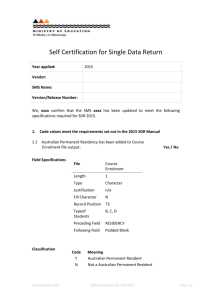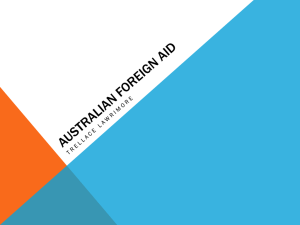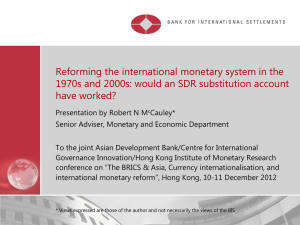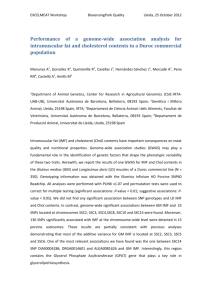The IMF and Danmarks Nationalbank's Balance Sheet
advertisement
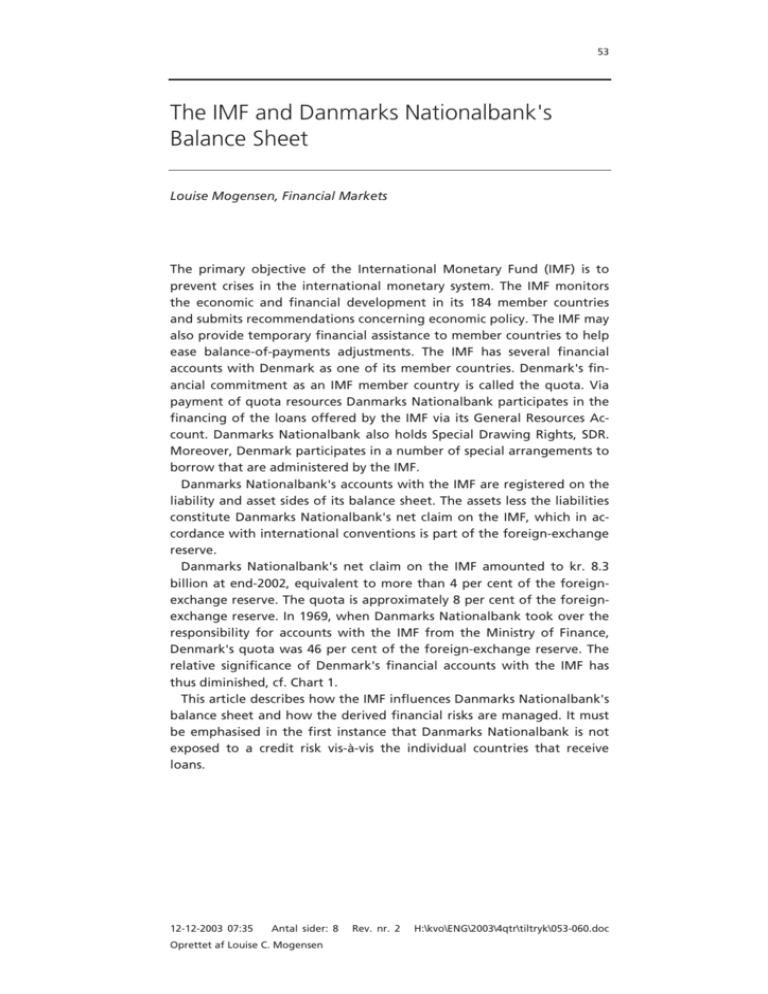
53 The IMF and Danmarks Nationalbank's Balance Sheet Louise Mogensen, Financial Markets The primary objective of the International Monetary Fund (IMF) is to prevent crises in the international monetary system. The IMF monitors the economic and financial development in its 184 member countries and submits recommendations concerning economic policy. The IMF may also provide temporary financial assistance to member countries to help ease balance-of-payments adjustments. The IMF has several financial accounts with Denmark as one of its member countries. Denmark's financial commitment as an IMF member country is called the quota. Via payment of quota resources Danmarks Nationalbank participates in the financing of the loans offered by the IMF via its General Resources Account. Danmarks Nationalbank also holds Special Drawing Rights, SDR. Moreover, Denmark participates in a number of special arrangements to borrow that are administered by the IMF. Danmarks Nationalbank's accounts with the IMF are registered on the liability and asset sides of its balance sheet. The assets less the liabilities constitute Danmarks Nationalbank's net claim on the IMF, which in accordance with international conventions is part of the foreign-exchange reserve. Danmarks Nationalbank's net claim on the IMF amounted to kr. 8.3 billion at end-2002, equivalent to more than 4 per cent of the foreignexchange reserve. The quota is approximately 8 per cent of the foreignexchange reserve. In 1969, when Danmarks Nationalbank took over the responsibility for accounts with the IMF from the Ministry of Finance, Denmark's quota was 46 per cent of the foreign-exchange reserve. The relative significance of Denmark's financial accounts with the IMF has thus diminished, cf. Chart 1. This article describes how the IMF influences Danmarks Nationalbank's balance sheet and how the derived financial risks are managed. It must be emphasised in the first instance that Danmarks Nationalbank is not exposed to a credit risk vis-à-vis the individual countries that receive loans. 12-12-2003 07:35 Antal sider: 8 Oprettet af Louise C. Mogensen Rev. nr. 2 H:\kvo\ENG\2003\4qtr\tiltryk\053-060.doc 54 DENMARK'S QUOTA AS A RATIO OF THE FOREIGN-EXCHANGE RESERVE, 1969-2002 Chart 1 Per cent 70 60 50 40 30 20 10 0 1969 1972 1975 1978 1981 1984 1987 1990 1993 1996 1999 2002 Note: The foreign-exchange reserve is calculated excluding the gold stock. Source: IMF, International Financial Statistics. THE IMF ON DANMARKS NATIONALBANK'S BALANCE SHEET Danmarks Nationalbank's annual accounts published in its Report and Accounts include only one IMF-related item on respectively the asset and the liability sides, cf. Table 1. The asset item can be broken down, however, so as to determine its sources and explain why it is subject to ongoing adjustment. Claims on the IMF consist of the following categories of accounts: the quota, SDR holdings, and the special arrangements to borrow: Poverty Reduction and Growth Facility, PRGF, and New Arrangements to Borrow, NAB. These accounts are all described below. Table 2 presents a breakdown of the asset item in Table 1. ACCOUNTS WITH THE IMF AS SHOWN IN REPORT AND ACCOUNTS 2002 Table 1 Kr. billion Assets Liabilities Claims on the International Monetary Fund (IMF), etc. ......... 8.3 Counterpart of Special Drawing Rights allocated by the International Monetary Fund (SDR) .......................................... 1.7 Source: Report and Accounts, 2002, Danmarks Nationalbank. 12-12-2003 07:35 Antal sider: 8 Oprettet af Louise C. Mogensen Rev. nr. 2 H:\kvo\ENG\2003\4qtr\tiltryk\053-060.doc 55 ACCOUNTS WITH THE IMF, BREAKDOWN Table 2 Balance sheet, end-2002, kr. billion Assets Quota (fixed) ............................. Holdings of SDR ........................ PRGF loans ................................. 15.8 0.7 0.6 NAB ............................................ 0 Liabilities The Fund's holdings of Danish kroner ............................................. Counterpart of allocated SDR ....... 8.9 1.7 Note: The counterpart of the allocated SDR on the liabilities side is not set off against the net claims, in accordance with the principles stipulated in the IMF's Balance of Payments Manual. PRGS stands for Poverty Reduction and Growth Facility which is a special arrangement to borrow for poor countries. NAB stands for New Arrangements to Borrow and is currently not in use. Danmarks Nationalbank's reserve position with the IMF is defined as the quota less the Fund's holdings of Danish kroner on Danmarks Nationalbank. The reserve position thus amounted to kr. 6.9 billion at end-2002 (kr. 15.8-8.9 billion). Source: Danmarks Nationalbank. The net claim on the IMF is included in the foreign-exchange reserve since it can be made available to Denmark at short notice. The counterpart of allocated SDR is not set off against the holdings of SDR, however. The explanation is that SDR is intended to be a reserve asset that is independent of gold or the balance-of-payments positions of other countries. A key aspect of the international agreement on allocation of SDR in 1969 was and is that the counterpart of allocated SDR should not be deducted from a country's foreign-exchange reserve. DANMARKS NATIONALBANK'S QUOTA Danmarks Nationalbank's membership contribution to the IMF is called the quota1. Denmark's quota amounts to SDR 1.6 billion, equivalent to kr. 15.8 billion, at the end of 2002. In principle, the quota is registered on both the liability and the asset sides. The liability side shows the Fund's holdings of Danish kroner while the asset side shows Danmarks Nationalbank's claim on the IMF. According to the IMF Articles of Agreement, one quarter of the quota must be paid to the IMF in SDR or in a currency widely used in the international foreign-exchange markets, such as the US dollar. Payment of dollars reduces the Fund's holdings of Danish kroner. The remaining three quarters of the quota constitute the Fund's holdings of Danish kroner before drawing on the quota. The difference between the quota and the Fund's holdings of Danish kroner is called Denmark's reserve position with the IMF. The Fund's holdings of Danish kroner, and thereby also the reserve position, are 1 The cooperation with the IMF is described in further detail at www.imf.org, www.nationalbanken.dk or in Danmarks Nationalbank's Annual Reports. 12-12-2003 07:35 Antal sider: 8 Oprettet af Louise C. Mogensen Rev. nr. 2 H:\kvo\ENG\2003\4qtr\tiltryk\053-060.doc 56 EXAMPLE OF LENDING KR. 1 BILLION IN DOLLARS VIA THE IMF Table 3 Changes in the balance sheet Assets Liabilities Quota, fixed ................................................ Dollar holdings in the foreign-exchange reserve ......................................................... 0 -1 The Fund's holdings of Danish kroner .......................... -1 Changes in the foreign-exchange reserve Quota, fixed ............................................................................................................... Reserve position ......................................................................................................... Dollar holding ............................................................................................................ 0 +1 -1 Foreign-exchange reserve, net ................................................................................. 0 Note: The reserve position increases since the quota is unchanged and the Fund's holding of Danish kroner decreases (Reserve position=Quota - the Fund's holding of Danish kroner). adjusted on an ongoing basis when the IMF either draws on or makes deposits to its account, while the quota, i.e. the IMF's maximum drawing, is fixed. The IMF's quota resources enable countries with balance-of-payments problems to raise loans from the IMF. The loans are granted via an exchange system which enables countries needing "hard" currency to buy currency via the IMF from countries whose foreign-exchange situation is favourable. The bookkeeping aspect of an IMF loan is illustrated in Table 3 by an example where a country purchases "hard" currency from the IMF and the IMF finances the entire purchase by drawing on Denmark. In practice, the financing of the IMF's lending is distributed among the countries (currently 44) that are eligible for inclusion in the IMF's Financial Transactions Plan in view of their favourable foreign-exchange and reserve position. Denmark's lending to other countries via the IMF under this arrangement does not affect the foreign-exchange reserve, since any drawing on the foreign-exchange reserve is set off by an increase in the reserve position, cf. Table 3. HOLDINGS OF SDR Danmarks Nationalbank's balance sheet also includes holdings of SDR (Special Drawing Rights)1. Denmark has been allocated SDR 179 million, corresponding to kr. 1.7 billion. The counterpart of the allocated SDR is 1 The value of SDR is calculated on the basis of a basket of currencies: euro, yen, pound sterling and dollar. SDR is potentially a claim on the other IMF countries' currencies, whereby owners of SDR may exchange amounts into these currencies. 12-12-2003 07:35 Antal sider: 8 Oprettet af Louise C. Mogensen Rev. nr. 2 H:\kvo\ENG\2003\4qtr\tiltryk\053-060.doc 57 Chart 2 ALLOCATION AND HOLDINGS OF SDR Million SDR 300 250 200 150 100 50 0 -50 -100 -150 1984 1986 Difference 1988 1990 1992 1994 SDR holdings 1996 1998 2000 2002 SDR allocation Source: IMF. a liability which by definition is fixed and is only adjusted when new SDR are allocated to the IMF member countries that participate in the SDR system1. The holdings of SDR constitute an asset made available to Danmarks Nationalbank. Countries requiring "hard" currency may exchange SDR via countries with excess international liquidity (or purchase SDR if required). In order to ensure the liquidity of the SDR system, Denmark like several other IMF member countries has concluded an agreement with the IMF for the exchange of SDR within a certain framework. Denmark's SDR exchange framework is SDR 25-300 million. Danmarks Nationalbank's holdings of SDR fluctuate within this framework, cf. Chart 2. In recent years, exchange of SDR has been initiated solely by the IMF's SDR Department which administers the arrangement. At the end of 2002 Danmarks Nationalbank's holdings of SDR amounted to SDR 76 million, corresponding to kr. 0.7 billion. This means that by that time Danmarks Nationalbank had sold SDR worth approximately kr. 1 billion in net terms out of the original SDR allocation. This arrangement does not affect the size of the foreign-exchange reserve either, since the holdings of SDR are already included in the 1 SDR were last allocated in 1981. In 1997 the IMF adopted a proposal to double the existing amount of SDR. The proposal would allocate the same amount of SDR to all IMF member countries as a ratio of the countries' quotas (29.315788813 per cent). Denmark has approved the proposal, but it has not yet been accepted by a sufficient number of countries for it to enter into force. The USA among other countries refuses to approve the proposal. 12-12-2003 07:35 Antal sider: 8 Oprettet af Louise C. Mogensen Rev. nr. 2 H:\kvo\ENG\2003\4qtr\tiltryk\053-060.doc 58 foreign-exchange reserve. If SDR are exchanged for e.g. dollars, Danmarks Nationalbank's dollar holdings will increase by an amount equivalent to the decrease in the SDR holdings, so that the total foreignexchange reserve remains unchanged. SPECIAL ARRANGEMENTS TO BORROW Besides quota resources and holdings of SDR Danmarks Nationalbank's lending via a special arrangement, the Poverty Reduction and Growth Facility, PRGF, of kr. 0.6 billion at end-2002 is also stated on the asset side of the balance sheet. Finally, Danmarks Nationalbank's participation in the New Arrangements to Borrow, NAB, is stated1. Under NAB it is possible to draw up to SDR 367 million (approximately kr. 3.5 billion at end-2002) on Danmarks Nationalbank, but this arrangement is currently not in use. The net claims on the IMF totalled kr. 8.3 billion at end-2002, cf. Tables 1 and 2. DANMARKS NATIONALBANK'S RISK VIS-À-VIS THE IMF Financial risks vis-à-vis the IMF can be divided into credit risk, currency risk and interest-rate risk. Danmarks Nationalbank's credit exposure to the IMF is considerable. However, the IMF has a very high credit standing, so that the credit risk is minimal. Danmarks Nationalbank seeks to minimise the interest-rate risk and currency risk2. Danmarks Nationalbank's credit exposure in connection with these arrangements can be divided into exposure vis-à-vis respectively the IMF, the PRGF "Trust Fund" and the SDR Department. Danmarks Nationalbank's credit exposure vis-à-vis the IMF is compiled as the sum of Danmarks Nationalbank's quota and loan commitments under the NAB arrangements. Subject to a government guarantee Danmarks Nationalbank has made a loan commitment under PRGF for a maximum of SDR 100 million (kr. 962 million at end-2002). The PRGF arrangements are administered by the IMF as a separate "Trust Fund" with its own (very large) reserves. 1 2 The two arrangements to borrow are described in further detail at www.imf.org. Danmarks Nationalbank's risk management is described in Ib Hansen and Christian Ølgaard, Danmarks Nationalbank's Risk Management, Danmarks Nationalbank, Monetary Review, 2nd Quarter 2000. 12-12-2003 07:35 Antal sider: 8 Oprettet af Louise C. Mogensen Rev. nr. 2 H:\kvo\ENG\2003\4qtr\tiltryk\053-060.doc 59 DANMARKS NATIONALBANK'S CREDIT EXPOSURE VIS-À-VIS THE IMF Table 4 Kr. billion End-2002 IMF Quota ................................................................................................ New Arrangements to Borrow, NAB ............................................... PRGF, Trust fund Poverty Reduction and Growth Facility ........................................... 15.8 3.5 1.0 SDR Department SDR (Maximum equivalent to twice the allocated amount) ......... 3.4 Total credit exposure ........................................................................ 23.7 Note: Lending under the PRGF arrangement is guaranteed by the Danish central government since it is administered by the IMF as a separate "Trust Fund". Danmarks Nationalbank's credit exposure vis-à-vis the SDR Department is compiled as its commitments to pay for SDR. Danmarks Nationalbank's maximum commitment is to buy SDR equivalent to twice the value of the allocated SDR, i.e. kr. 3.4 billion at end-2002. Table 4 shows the total credit exposure. Danmarks Nationalbank does not assume credit risk vis-à-vis third countries in connection with loans or exchange of quota resources or SDR, since all claims are on the IMF, the SDR Department or the special arrangements to borrow. Due to the IMF's high credit standing the credit risk is found to be low. The credit standing is the result of the international agreements to which the member countries are mutually committed under the IMF's Articles of Agreement as well as the IMF's reserves, including considerable gold reserves1. Danmarks Nationalbank is exposed to an immediate currency risk in SDR, since accounts with the IMF are settled in SDR. In the management of Danmarks Nationalbank's currency risk the value of SDR is distributed on the currencies included in the calculation of SDR, and forward transactions are then concluded so that the risk is solely vis-à-vis the euro, which is the target of Denmark's fixed-exchange-rate policy. It follows that purchase and sale of SDR do not affect Danmarks Nationalbank's currency exposure, making it possible to keep the currency risk vis-à-vis the IMF at a very low level. The IMF's remuneration of SDR is a weighted 3-month interest rate from the USA, Japan, the euro area and the UK. The rate of interest on the reserve position is reduced by a contribution (in October 2003 ap1 The gold reserve amounts to approximately 3,200 tonnes as of 31 July 2003 and is stated in the IMF's "Financial Statement" at historical cost price as determined by the IMF's Articles of Agreement. Since this is considerably less than the market value, the gold holdings constitute a considerable hidden reserve for the IMF. 12-12-2003 07:35 Antal sider: 8 Oprettet af Louise C. Mogensen Rev. nr. 2 H:\kvo\ENG\2003\4qtr\tiltryk\053-060.doc 60 proximately 0.1 per cent) to cover the IMF's administration and to build up reserve funds within the IMF1. Danmarks Nationalbank seeks to minimise the interest-rate risk vis-àvis the IMF since all transactions in connection with the arrangements to borrow and the exchange of SDR are kept neutral for the duration of the foreign-exchange reserve. Transactions solely entail adjustments to the money-market placements of the foreign-exchange reserve. 1 Danmarks Nationalbank's outstanding loans under the PRGF arrangements are also remunerated at the SDR interest rate. However, the poor developing countries receiving loans under this arrangement pay interest at only 0.5 per cent per annum. The difference between the market-determined SDR interest rate and the low lending rate is covered by interest subsidies. It should be emphasised that these interest subsidies are covered by the industrialised countries and other rich countries via their development aid budgets (DANIDA in Denmark). Danmarks Nationalbank does not contribute interest subsidies to this arrangement. 12-12-2003 07:35 Antal sider: 8 Oprettet af Louise C. Mogensen Rev. nr. 2 H:\kvo\ENG\2003\4qtr\tiltryk\053-060.doc



